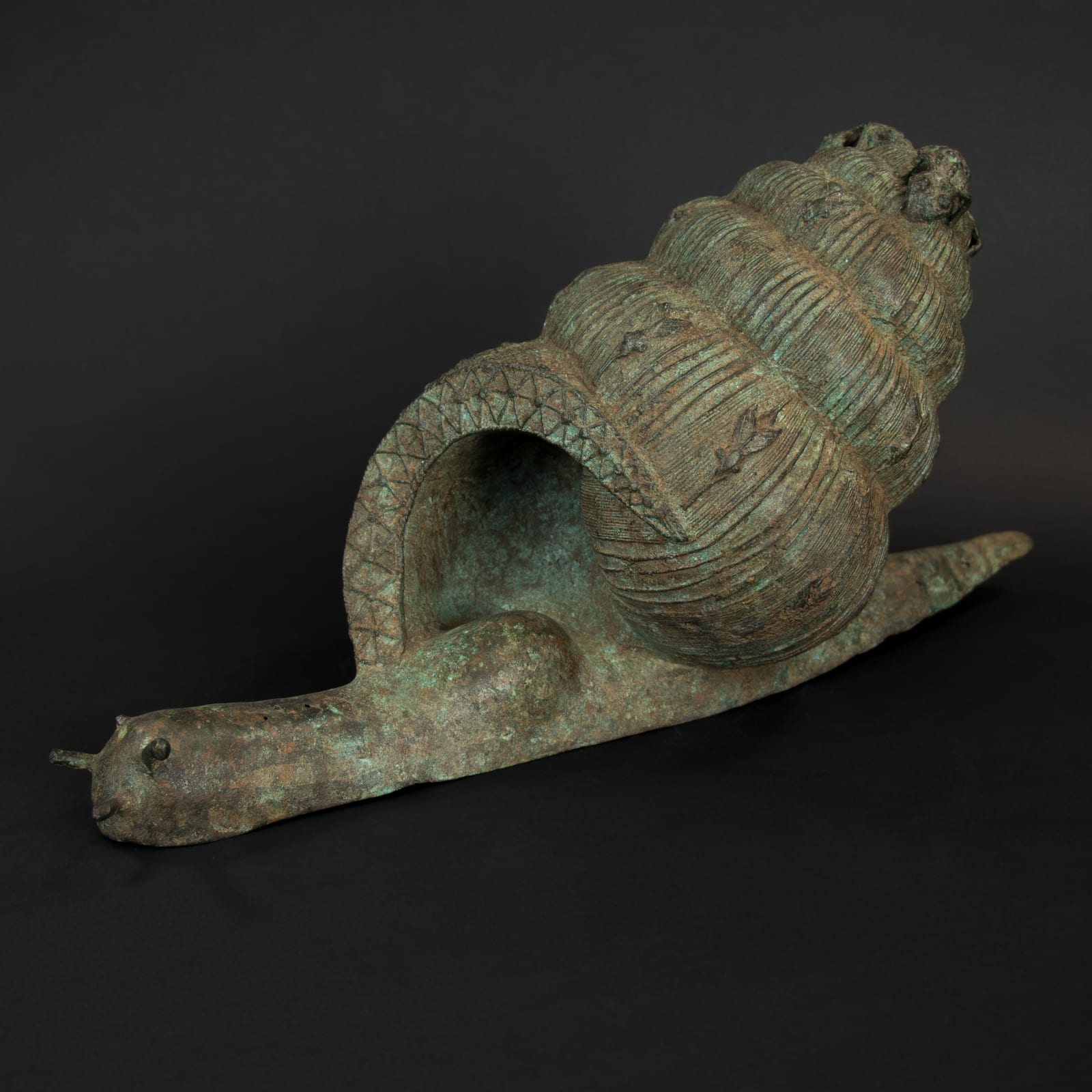Igbo-Ukwu Bronze Snail, 19th to 20th century AD
Bronze
25 x 54 cm
9 7/8 x 21 1/4 in
9 7/8 x 21 1/4 in
ES.6506
Further images
The Igbo (Ibo) of the Northern Niger River Delta are one of the largest and most important tribal groups in West Africa. They are culturally highly complex, with a political...
The Igbo (Ibo) of the Northern Niger River Delta are one of the largest and most important tribal groups in West Africa. They are culturally highly complex, with a political system based upon a loose form of chiefdom/kingship in some areas, and a democratic panel of decision-makers in others. Social life was usually governed by a number of secret societies. Their main god is Chukwu (literally “Great Spirit”), the creator of the world, who is also linked to the sun and all that grows and lives. Social conduct is governed by Ogu-na-Ofo, spirits who defend the innocent against unjust charges. If a guilty person appeals to them for help, they will be cursed by Amadioha (the god of thunder and lightning). There are numerous other gods that deal with issues as diverse as Ahia Njoku (yams) to Ikenga (fortune and industry) and Agwu (medicine men). Each person has a god named Chi, which is essentially an embodiment of a person’s fate.
The Igbo are known for their artistic diversity, due to the wide range of environments and local histories to which their culture is exposed. This beautiful snail is also presumed to be from Igbo Isaiah, the regalia storehouse. The shell could be interpreted as representing an African land snail, but experts have identified comparables rather as representing triton shells from the sea. This is enormously fascinating, as the coast is approximately 100 miles away from the city of Igbo-Ukwu, and it is intriguing to wonder whether the sea was a source of trade or had a ritual association. The designs found on this work of art are characteristic of other examples of Igbo lost-wax bronze-work found in that region. This is clearly seen in the raised ridges and other patterns found over much of the piece. These designs are very similar to, and are thought to be based on, scarification patterns found on the faces of high-ranking Igbo men. This type of scarification pattern is known as ichi and it represents someone with a high degree of learning and status. This would link this object with the artwork of the aristocracy of Igbo-Ukwu. This would make sense since very similar bronze representations of snail shells have been found in the burial chambers of high-ranking men found in the city.
The pointed end of the shell is decorated with three frogs. The rest of the shell surface has a network of parallel lines, crosshatchings, and granulations typical of Igbo Ukwu. Scattered across this are relief sculptures of flies. These insects, along with beetles and spiders, are often depicted on the bronzes of Igbo Ukwu. Perhaps they reflected the importance of controlling such insects on the yam crop or illustrated a now-forgotten ritual metaphor.
The Igbo are known for their artistic diversity, due to the wide range of environments and local histories to which their culture is exposed. This beautiful snail is also presumed to be from Igbo Isaiah, the regalia storehouse. The shell could be interpreted as representing an African land snail, but experts have identified comparables rather as representing triton shells from the sea. This is enormously fascinating, as the coast is approximately 100 miles away from the city of Igbo-Ukwu, and it is intriguing to wonder whether the sea was a source of trade or had a ritual association. The designs found on this work of art are characteristic of other examples of Igbo lost-wax bronze-work found in that region. This is clearly seen in the raised ridges and other patterns found over much of the piece. These designs are very similar to, and are thought to be based on, scarification patterns found on the faces of high-ranking Igbo men. This type of scarification pattern is known as ichi and it represents someone with a high degree of learning and status. This would link this object with the artwork of the aristocracy of Igbo-Ukwu. This would make sense since very similar bronze representations of snail shells have been found in the burial chambers of high-ranking men found in the city.
The pointed end of the shell is decorated with three frogs. The rest of the shell surface has a network of parallel lines, crosshatchings, and granulations typical of Igbo Ukwu. Scattered across this are relief sculptures of flies. These insects, along with beetles and spiders, are often depicted on the bronzes of Igbo Ukwu. Perhaps they reflected the importance of controlling such insects on the yam crop or illustrated a now-forgotten ritual metaphor.











